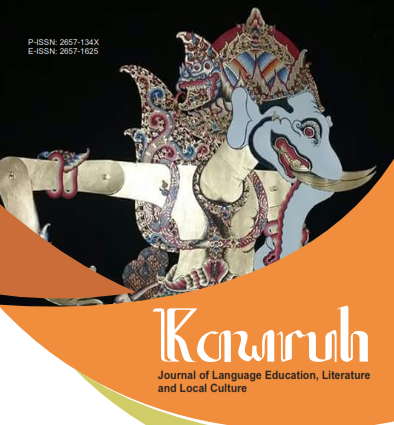Diskursus Karya Seni, Kreator, Dan Kapitalisme
DOI:
https://doi.org/10.32585/kawruh.v4i1.2193Keywords:
Discourse, Identity, Capitalism, Art Work, CreatorAbstract
This paper departs from the fact that capitalism has reached the stage of complete domination and hegemony. Art products, the art market, and creators are strongly influenced by the ups and downs of the market, the atmosphere and monetary stability, and market players such as auction houses, curators, collectors, collectors, art dealers, patronage, and the mass media. In such a position, it raises the question of how the position of the creator and his work in dealing with enthusiasts and observers of art, markets, and capitalism. Do the creators voluntarily submit and obey the choice to join the capitalist game, or do the creators have a strong bargaining position to maintain idealism and enthusiasm not to get caught up in the game of capital and political games. It is a document study, this article to answer the above questions. As a result, there are two perspectives: first, the perspective of artwork as a commodity that occurs in the current era, and the second is the artwork as an aesthetic object. In the perspective of art as a commodity, creators generally follow market tastes, assisted by patronage, collectors or collectors, and other elements such as curators and mass media. This capitalism employs a strategy called “frying fry.” The second perspective is the artwork as prestige and increasing social status. In this era, creators still have a good bargaining position because there are no market access constraints.Downloads
References
Agnes, T. (2018). Kerap Dilabeli “Seniman Gorengan”, Ini Kata Nasirun. DetikHot. https://hot.detik.com/spotlight/d-4033038/kerap-dilabeli-seniman-gorengan-ini-kata-nasirun
Andrianto, T. (n.d.). Jika Lukisan “digoreng”, maka harganya akan mahal. https://thomasandrianto.wordpress.com/2010/05/26/jika-lukisan-digoreng-maka-harganya-akan-mahal/
Barker, C. (2015). Cultural Studies:Teori dan Praktik. Bentang.
Durkheim, E. (1988). Les Regles de La Methode Sociologique. Champs Flammarion.
FS, A. (2018). Visual Branded pada Karya Nyoman Masriadi. Artspace.Id. https://artspace.id/2018/01/11/visual-branded-pada-karya-nyoman-masriadi/
Gbadamosi, A. (2019). Contemporary Issues in Marketing : Principles and Practices. Sage Publications.
Kotler, Philip; Keller, K. L. (2016). Marketing Managemet. Pearson.
Purwasito, A. (2017). L’Ars Factum, Metodologi Penciptaan Seni. UNS Press.
Rhine, A. (2020). Marketing of the Arts. Rowman&Littlefield.
Sindhunata. (2020). Teori Kritis Sekolah Frankfurt. Gramedia.
Venter, Peet; Jansen van Rensburg, M. (2014). The Relationship Between Marketing Intelligence and Strategic Marketing. South African Journal of Economic and Management Sciences, 17(4), 440–156. https://doi.org/10.4102/sajems.v17i4.642
Weber, M. (2001). Etika Protestan dan Semangat Kapitalisme. Pustaka Promethea.
Yofanka, M. (2020). Produk Kapitalisme Satu Lagi: Seni Tanpa Jati Diri. Economica.Id. https://www.economica.id/2020/07/11/produk-kapitalisme-satu-lagi-seni-tanpa-jati-diri/
Downloads
Published
How to Cite
Issue
Section
License
Authors who publish with the Kawruh: Journal of Language Education, Literature and Local Culture agree to the following terms:
- Authors retain copyright and grant the journal the right of first publication with the work simultaneously licensed under a Creative Commons Attribution License (CC BY-SA 4.0) that allows others to share the work with an acknowledgment of the work's authorship and initial publication in this journal.
- Authors are able to enter into separate, additional contractual arrangements for the non-exclusive distribution of the journal's published version of the work (e.g., post it to an institutional repository or publish it in a book), with an acknowledgment of its initial publication in this journal.
- Authors are permitted and encouraged to post their work online (e.g., in institutional repositories or on their website) prior to and during the submission process, as it can lead to productive exchanges, as well as earlier and greater citation of published work.




